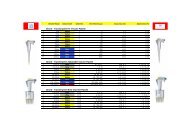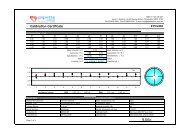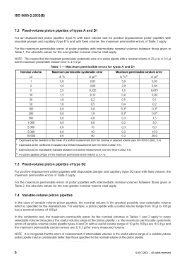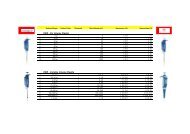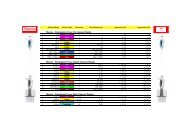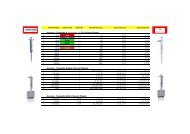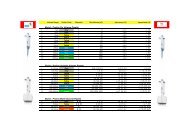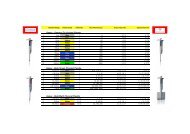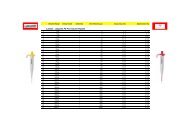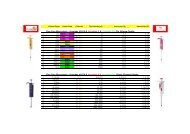User checks and maintenance of laboratory balances - Pipette Clinic
User checks and maintenance of laboratory balances - Pipette Clinic
User checks and maintenance of laboratory balances - Pipette Clinic
- No tags were found...
You also want an ePaper? Increase the reach of your titles
YUMPU automatically turns print PDFs into web optimized ePapers that Google loves.
Technical Note 13 - <strong>User</strong> <strong>checks</strong> <strong>and</strong> <strong>maintenance</strong> <strong>of</strong> <strong>laboratory</strong> <strong>balances</strong>5. Correct use <strong>of</strong> <strong>balances</strong>Tare function/zero checkThis operation must be performed prior to each weighing to ensure the balance is at zero <strong>and</strong> has not driftedsince the last reading. It must be remembered, however, that taring should only be carried out initially whenperforming either the scale value or repeatability user <strong>checks</strong>.Many <strong>balances</strong> now come with zero tracking facilities. When a mass is removed, the balance willautomatically re-zero itself. When removing samples, care must be taken to ensure the pan is kept clean <strong>of</strong>spilt material. Material left on the pan will be tared out which will lead to errors if it is removed duringsubsequent weighings.<strong>User</strong> <strong>checks</strong>Scale value <strong>and</strong> repeatability <strong>checks</strong> may be performed at any time. The minimum frequency required byNATA is every month for the scale value (single point) check <strong>and</strong> every six months for the repeatabilitycheck. Refer to Section 7 for guidance on user <strong>checks</strong>.6. Full calibrationThis shall be undertaken at least every three years in accordance with the NATA Accreditation Requirements<strong>and</strong> shall be performed at the <strong>laboratory</strong> where the balance is to be used.A NATA, or equivalent, endorsed report is required covering the calibration except where the <strong>laboratory</strong> isapproved to perform in-house balance calibrations. (See NATA Technical Note 28). The calibration authoritymust use reference st<strong>and</strong>ards that are appropriate <strong>and</strong> traceable to a national st<strong>and</strong>ard for mass. Refer toNotes 4 <strong>and</strong> 5.The Limit <strong>of</strong> Performance <strong>of</strong> the balance obtained from the calibration certificate for each range needs tobe checked to ensure it is fit for use prior to putting the balance into operation after each calibration.In order to assess the user <strong>checks</strong> described below, the following information needs to be obtained from thecalibration certificate:• The limit <strong>of</strong> performance for each range calibrated (F);• The maximum st<strong>and</strong>ard deviation <strong>of</strong> the repeatability readings (s r (max));• The maximum scale reading correction (C max );• The exp<strong>and</strong>ed uncertainty associated with the maximum correction. U(C max ).Weights <strong>and</strong> measures reportsState weights <strong>and</strong> measures authorities are normally Verifying Authorities which provide legal traceability formasses <strong>and</strong> volumetric measures. NATA accepts calibrations for masses carried out by Verifying Authorities(even those which are not accredited) provided that they are reported on a Regulation 13 (previously aRegulation 80) certificate. However, some <strong>of</strong> these bodies perform other calibrations (eg. <strong>balances</strong>) whichare outside the scope <strong>of</strong> their Verifying Authority appointment. NATA does not accept these calibrationcertificates.Further information <strong>and</strong> a listing <strong>of</strong> Verifying Authorities is available on the National Measurement Institute(NMI) website at www.measurement.gov.au.7. <strong>User</strong> <strong>checks</strong>Scale value check <strong>and</strong> massesScale value <strong>checks</strong> are performed to ensure that the balance output continues to give the same value for thesame known mass. In this way, the scale value check compares the current performance <strong>of</strong> the balanceagainst its performance at the time <strong>of</strong> the previous full calibration <strong>of</strong> the balance. As this is only a user check<strong>and</strong> not a calibration, the masses do not have the same rigorous traceability requirements as do massesused for the calibration procedure.The important aspects are that the value <strong>of</strong> the mass be:• known;• stable (ie. does not vary from one check to the next); <strong>and</strong>• close to the full capacity (ie. not less than 80%) <strong>of</strong> the balance range being checked.Page 3 <strong>of</strong> 9
Technical Note 13 - <strong>User</strong> <strong>checks</strong> <strong>and</strong> <strong>maintenance</strong> <strong>of</strong> <strong>laboratory</strong> <strong>balances</strong>Masses should be <strong>of</strong> symmetrical shape (usually cylindrical) so that the mass can be centred <strong>and</strong> evenlydistributed on the balance. In order to identify changes in instrument performance, it is essential that thesame mass/masses be used each time, unless a certified mass is used.A user assigned mass can be used. These non calibrated masses must be placed on each balance at thetime a full calibration <strong>of</strong> the balance is performed <strong>and</strong> the displayed value is assigned to it. Refer to Note 6.It should be noted that such a mass is not calibrated but has had a value assigned to it relative to thatbalance. The assigned value must be determined for each balance, or balance range, on which the mass isto be used. Refer to Note 7.Alternatively, a certified mass may be used provided the value <strong>of</strong> the mass has been determined by aNATA accredited <strong>laboratory</strong> that has provided an endorsed report detailing the calibrated value <strong>of</strong> the mass<strong>and</strong> the uncertainty <strong>of</strong> that measurement.Which option to choose ?<strong>User</strong> assigned masses are an economical option. Certified masses are generally only used at a central<strong>laboratory</strong> as they are not usually available for monthly use at laboratories remote from a central <strong>laboratory</strong>.Laboratories are encouraged to have user assigned masses readily available as they can be used as ameans <strong>of</strong> checking the performance <strong>of</strong> a balance at any time. For example, if test results appear doubtful orresults have been challenged.Scale value check procedure(Reference: The Calibration <strong>of</strong> Weights <strong>and</strong> Balances, E Morris <strong>and</strong> K Fen, Australian Government NationalMeasurement Institute).a) Tare the balance <strong>and</strong> record the zero reading (z 1 );b) Place the calibrated or assigned value mass(es) (mass M) on the balance <strong>and</strong> record the indicatedmass (m 1 );c) Remove the mass(es) from the balance. Do not tare the balance;d) Place the calibrated or assigned value mass(es) on the balance <strong>and</strong> record the indicated mass (m 2 );e) Remove the mass(es) from the balance <strong>and</strong> record the balance reading (z 2 ).Calculate the correction for each separate weighing:C 1 = M – (m 1 – z 1 )C 2 = M – (m 2 – z 2 )Correction = 0.5(C 1 + C 2 )If the change in correction is less than 3 times s r (max) the balance is fit for continued use. Otherwise thebalance may need repair or adjustment (see also under assessment <strong>of</strong> user <strong>checks</strong> where the limit <strong>of</strong>performance can be used to determine if the balance is still fit for purpose).Repeatability checkThe repeatability check seeks to determine if the balance output changes with repeated measurements(ie. 10) <strong>of</strong> the same mass. It is the change in the magnitude <strong>of</strong> the spread <strong>of</strong> responses (st<strong>and</strong>ard deviation)that is important, <strong>and</strong> this is compared with the st<strong>and</strong>ard deviation obtained at the last full calibration <strong>and</strong>reported on the calibration report. One set <strong>of</strong> repeatability <strong>checks</strong> should be performed in each measurementrange <strong>of</strong> the balance.For a repeatability check it is important that the weight <strong>of</strong> the mass used remains constant throughout theperiod between <strong>checks</strong>. It does not need to be a certified mass or have an assigned value. The weight<strong>of</strong> the mass should be close to the maximum weighing capability <strong>of</strong> the balance (or <strong>of</strong> each scale range for adual scale or poly-range balance). However, for convenience, the certified or user-assigned mass used forthe scale value check is usually used for the repeatability rather than using two different masses (or sets <strong>of</strong>masses).Page 4 <strong>of</strong> 9
Technical Note 13 - <strong>User</strong> <strong>checks</strong> <strong>and</strong> <strong>maintenance</strong> <strong>of</strong> <strong>laboratory</strong> <strong>balances</strong>Repeatability check procedure(Reference: The Calibration <strong>of</strong> Weights <strong>and</strong> Balances, E Morris <strong>and</strong> K Fen, Australian Government NationalMeasurement Institute).a) Tare the balance <strong>and</strong> record the zero reading (z 1 );b) Place the selected mass(es) which is close to the maximum capacity <strong>of</strong> the range being checked onthe balance <strong>and</strong> record the indicated reading (m 1 );c) Remove the mass(es) from the balance <strong>and</strong> record the balance reading (z 2 );d) Without taring the balance, place the same selected mass(es) on the balance <strong>and</strong> record theindicated reading (m 2 );e) Remove the mass(es) from the balance <strong>and</strong> record the balance reading (z 3 );f) Repeat (d) <strong>and</strong> (e) so that 10 complete set <strong>of</strong> readings are obtained.Calculate the difference (r i ) between each reading <strong>and</strong> its corresponding zero reading:r i = m i – z iCalculate the st<strong>and</strong>ard deviation (s) <strong>of</strong> the difference r 1, r 2, ..…r n from the formulas = √ [Σ (r i – R) 2 / (n – 1)]Where i = 1 to n, <strong>and</strong> R = mean <strong>of</strong> the values <strong>of</strong> r iIf the st<strong>and</strong>ard deviation (s) is less than twice s r (max) the balance is fit for continued use (see also underAssessment <strong>of</strong> user <strong>checks</strong>).Assessment <strong>of</strong> user <strong>checks</strong>If there are significant changes, as measured by the user <strong>checks</strong>, then recalibration may be warranted.However, before recalibration is considered, the following should be undertaken:1. Check <strong>and</strong> rectify any environmental problems:• are there draughts or vibrations?• is the balance level?• are there any interferences with the pan ie. dirt or cover contacting the pan?• with more precise <strong>balances</strong>, check draught covers for static electricity (if static electricity is aproblem the draught shield needs to be treated with an anti-static spray).• is there any magnetic interference?• is the balance affected by temperature changes?2. Repeat the check.3. If the balance still fails the check, then it is useful to determine what effect this change inperformance has had on previous test results obtained using this balance. This should influence thedecision as to whether or not the balance requires servicing <strong>and</strong> recalibration. This will depend upon:• the limit <strong>of</strong> performance required by the test methods for which the balance is used.• the limit <strong>of</strong> performance <strong>of</strong> the balance as established at the last full calibration.• the magnitude <strong>of</strong> the change in the limit <strong>of</strong> performance <strong>of</strong> the balance.Limit <strong>of</strong> performanceTo assist with the above decisions, it may be helpful to make a rough estimation <strong>of</strong> the current limit <strong>of</strong>performance (F) <strong>of</strong> the balance using the following formula:Where:F = 2.26 s w + |Corr w | + Us wis the larger repeatability st<strong>and</strong>ard deviation <strong>of</strong>:a) that reported on the last full calibration report; <strong>and</strong>b) that determined by the user repeatability check.Page 5 <strong>of</strong> 9
Technical Note 13 - <strong>User</strong> <strong>checks</strong> <strong>and</strong> <strong>maintenance</strong> <strong>of</strong> <strong>laboratory</strong> <strong>balances</strong>|Corr w |is the absolute value <strong>of</strong> the larger scale correction <strong>of</strong>:a) the largest value <strong>of</strong> the correction reported on the last full calibration report; <strong>and</strong>b) that determined by the user scale value check.Uis the exp<strong>and</strong>ed uncertainty associated with |Corr w | as shown on the calibration report.If there is any doubt whether or not the balance requires recalibration, the calibration authority who lastcalibrated the balance should be consulted. These authorities are usually conversant with the particular limitson capabilities <strong>and</strong> specifications <strong>of</strong> the various models <strong>of</strong> <strong>balances</strong>. If there has been a significant change, itwill also be necessary to determine the possible effect on test results which have been obtained using thebalance in the period prior to this check <strong>and</strong> subsequent to the last satisfactory check.Note.All <strong>of</strong> the above steps <strong>and</strong> <strong>checks</strong> constitute the corrective actions for that balance <strong>and</strong> must bedocumented.8. Specimen worksheetsTwo worksheets have been provided at the end <strong>of</strong> this document as suggested formats for recording data <strong>of</strong>balance user <strong>checks</strong>.9. NotesNote 1:Note 2:Note 3:Dust is a problem if it gets into the balance mechanism. There is usually very little clearancebetween the pan spindle <strong>and</strong> wall <strong>of</strong> the force compensation cell. Quarries <strong>and</strong> construction sitesin particular can pose dust problems.Opening <strong>of</strong> doors, windows <strong>and</strong> operation <strong>of</strong> fans <strong>and</strong> air conditioners can affect balanceoperation. It has even been found that an air conditioner output bouncing <strong>of</strong>f the adjacent wall issufficient to affect the stability <strong>of</strong> some <strong>balances</strong>.If there is a possibility that a mass is magnetic, the best way to check if it is affecting the readingis as follows. Compare the indicated value <strong>of</strong> the mass when placed directly on the pan againstthe indicated value when the mass is raised 10-15 cm above the pan on a tared, non-magneticspacer. The magnitude <strong>of</strong> the effect could be up to 1 g in 1000 g. Larger, less predictable,changes can be caused by moving a large mass <strong>of</strong> magnetic material from under, or alongside,a balance.Electronic <strong>balances</strong> should not be located near equipment/machinery with a strong electric field,eg. electric grinders, due to the possible ingress <strong>of</strong> magnetic material into the weighing cell. Thiscan cause disproportionate errors due to the effect <strong>of</strong> the lever ratio in the mechanism.Note 4:Note 5:In-house calibrations may only be conducted for the <strong>laboratory</strong>’s own use either within the<strong>laboratory</strong> itself, or at a central calibration <strong>laboratory</strong> carrying out calibrations for otherdepartments within their own company (see NATA Technical Note 28). In-house calibrationsmust be performed, at the <strong>laboratory</strong> where the balance is to be used.If the full range <strong>of</strong> a balance is not required, then it is only necessary to calibrate <strong>and</strong> check thatportion <strong>of</strong> the range* <strong>of</strong> the balance actually used. If this is the case, the calibration is performedas if this reduced range is the full range <strong>of</strong> the balance <strong>and</strong> all calibration readings must be takenin this nominated, reduced range. However adequate warning, by way <strong>of</strong> a sign above or on thebalance, must be given to prevent users inadvertently using the uncalibrated portion <strong>of</strong> the range<strong>of</strong> the balance.Alternatively, it may be appropriate in some cases to request that the calibration authoritycalculate the Limit <strong>of</strong> Performance for the balance over different working ranges* for which thebalance is to be used. For example, a 30 kg balance may have a limit <strong>of</strong> performance <strong>of</strong> ± 0.4 gup to 10 kg but a limit <strong>of</strong> performance <strong>of</strong> ± 2.5 g up to 30 kg. If the limit <strong>of</strong> performance <strong>of</strong> thebalance is just reported as “± 2.5 g”, this balance would be deemed unsuitable for applicationrequiring a limit <strong>of</strong> performance <strong>of</strong> ± 0.5 g or better. If, however, both limit <strong>of</strong> performances werereported with their ranges then the balance would meet the requirements <strong>of</strong> ± 0.5 g up to 10 kg<strong>and</strong> would also meet the requirements <strong>of</strong> ±5 g up to 30 kg.Page 6 <strong>of</strong> 9
Technical Note 13 - <strong>User</strong> <strong>checks</strong> <strong>and</strong> <strong>maintenance</strong> <strong>of</strong> <strong>laboratory</strong> <strong>balances</strong>If this option is chosen, the balance must be clearly identified with these limitations <strong>and</strong> the user<strong>checks</strong> must be performed in all <strong>of</strong> these ranges to ensure that the balance continues to meetthe different requirements <strong>of</strong> each range.* These ranges may be defined by the <strong>laboratory</strong> depending upon the balance capacities<strong>and</strong> limits <strong>of</strong> performance required by the test methods.Note 6:Calibrating authorities at the time <strong>of</strong> full calibration are usually prepared to weigh massesnominated by the user <strong>and</strong> will include the displayed values (ie. assigned mass readings)obtained in the balance calibration report. Alternatively, users can do this themselves provided itis performed on the same day that the balance is calibrated <strong>and</strong> they record the values obtained.It is important that all the masses to be used are checked in the manner in which they are to beused <strong>and</strong> not just as single masses.Example:If the <strong>laboratory</strong> has three 2 kg masses which are to be used to check 3 <strong>balances</strong> – one <strong>of</strong> 2 kgcapacity, one <strong>of</strong> 4 kg capacity <strong>and</strong> another <strong>of</strong> 6 kg capacity, then:• all three masses need to be placed on the 6 kg balance <strong>and</strong> the total mass recorded.• two 2 kg masses similarly placed on the 4 kg balance (the actual marking <strong>of</strong> the masses tobe recorded) <strong>and</strong> the total mass recorded.• if any one <strong>of</strong> the 2 kg masses is to be used for checking the 2 kg balance, then each mustbe placed separately on the balance <strong>and</strong> the mass <strong>and</strong> identification <strong>of</strong> the mass recorded.Alternatively if only one <strong>of</strong> the 2 kg mass is used then only its mass needs to be assigned<strong>and</strong> its identification recorded.Note 7:The assigned value is purely for a particular balance/mass combination <strong>and</strong> will not have hadany balance corrections applied to it. If, for example, a <strong>laboratory</strong> has three <strong>balances</strong> <strong>and</strong> thesame mass is used for scale value <strong>checks</strong> on all three, it will be necessary to determine anassigned value appropriate for each <strong>of</strong> the <strong>balances</strong> at the time <strong>of</strong> each three-yearly balancecalibration.For example:BalanceBalance 1Balance 2Balance 3Assigned value for mass “A”1000.7 g1000.4 g1000.9 gThe same mass was used but each balance gave a different value. The individual assignedvalue obtained for that balance must be used in the user <strong>checks</strong> performed for that balanceeg. Balance 2 must use the assigned value 1000.4 g for mass “A”.10. ReferencesThe Calibration <strong>of</strong> Weights <strong>and</strong> Balances, E Morris <strong>and</strong> K Fen, Australian Government NationalMeasurement Institute.NATA Technical Note 28 – In-house calibrations <strong>and</strong> measurement uncertainty.Page 7 <strong>of</strong> 9
Technical Note 13 - <strong>User</strong> <strong>checks</strong> <strong>and</strong> <strong>maintenance</strong> <strong>of</strong> <strong>laboratory</strong> <strong>balances</strong>(Name <strong>of</strong> Laboratory or Section)Record <strong>of</strong> monthly single point checkMAKE: MODEL: MAXIMUM LOAD:TYPE:SERIAL NO:(Single pan / top loading / digital readout / “delta” range)LOCATION:SCALE RANGE: SCALE DIVISION: READABILITY:DATE CHECKED:Single point checkReference: The Calibration <strong>of</strong> Weights <strong>and</strong> Balances, E Morris <strong>and</strong> K Fen Australian Government, NationalMeasurement InstituteThe departure <strong>of</strong> the scale from its nominal value is measured close to maximum capacity.Certified calibrating mass (M)lst zero reading (z 1 )lst reading <strong>of</strong> st<strong>and</strong>ard mass (m 1 )2nd reading <strong>of</strong> st<strong>and</strong>ard mass (m 2 )2nd zero reading (z 2 )= __________= __________= __________= __________= __________C 1 = M – (m 1 – z 1 )C 2 = M – (m 2 – z 2 )Correction = (C 1 + C 2 )_________________2= __________= __________= __________Note: If the correction has changed by more than 3 times the st<strong>and</strong>ard deviation <strong>of</strong> the repeatability determined at thelast 3-yearly calibration then the balance may require servicing, adjustment <strong>and</strong> calibration.Testing <strong>of</strong>ficer: __________________________________________________________________________Checked by: ____________________________________________________________________________Comments:Page 8 <strong>of</strong> 9
Technical Note 13 - <strong>User</strong> <strong>checks</strong> <strong>and</strong> <strong>maintenance</strong> <strong>of</strong> <strong>laboratory</strong> <strong>balances</strong>(Name <strong>of</strong> Laboratory or Section)Record <strong>of</strong> six monthly repeatability checkMAKE: MODEL: MAXIMUM LOAD:TYPE:SERIAL NO:(Single pan / top loading / digital readout / “delta” range)LOCATION:SCALE RANGE: SCALE DIVISION: READABILITY:DATE CHECKED:Repeatability <strong>of</strong> reading (Six-monthly check)Reference: The Calibration <strong>of</strong> Weights <strong>and</strong> Balances, E Morris <strong>and</strong> K Fen Australian Government, NationalMeasurement InstituteCalibrating Mass (M) =gNumber Pan load Scale reading(mg)Difference (mg)r = m – z1 0 z 1 = r 1 =M m 1 =2 0 z 2 = r 2 =M m 2 =3 0 z 3 = r 3 =M m 3 =4 0 z 4 = r 4 =M m 4 =5 0 z 5 = r 5 =M m 5 =6 0 z 6 = r 6 =M m 6 =7 0 z 7 = r 7 =M m 7 =8 0 z 8 = r 8 =M m 8 =9 0 z 9 r 9 =M m 9 =10 0 z 10 = r 10 =M m 10 =St<strong>and</strong>ard Deviation s = √ [Σ (r i – R) 2 / (n – 1)]wherei = 1 to n, r i = m i – z i , <strong>and</strong> R = mean <strong>of</strong> values <strong>of</strong> rNote: If the new value <strong>of</strong> the st<strong>and</strong>ard deviation is greater than twice the value obtained when the balance was lastcalibrated (ie. 3-yearly calibration), then the balance may require calibration, <strong>and</strong> possibly servicing <strong>and</strong> adjustment.Alternatively the Limit <strong>of</strong> Performance may be recalculated to determine whether the balance is still suitable for the user'sneeds.Checked by:Page 9 <strong>of</strong> 9




